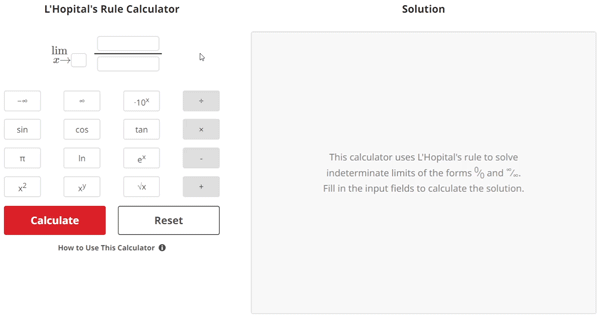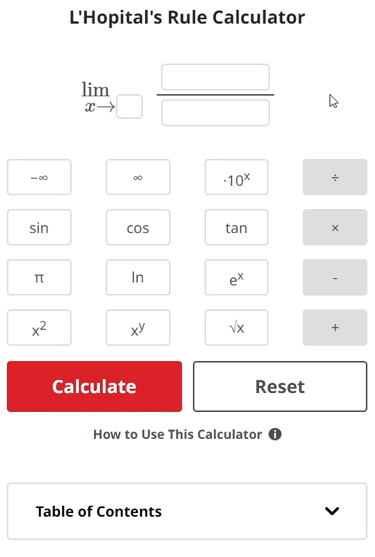L'Hopital's Rule Calculator
Solution

Fill in the input fields to calculate the solution.

L'Hopital's Rule Lesson
What is L'Hopital's Rule?
L'Hopital's rule is a theorem that allows us to evaluate limits that result in indeterminate fractional forms, by taking the derivative of the function on the top of the fraction and taking the derivative of the function on the bottom of the fraction.
Sometimes when evaluating the limit of a function we end up with an indeterminate form. Indeterminate means it does not have a defined value. As an example, let's look at the following limit:
$$\lim_{x \to 2} \frac{x^2+x-6}{x^2-4}$$
Evaluating the limit at x = 2, we get:
$$ \frac{(2)^2+(2)-6}{(2)^2-4} = \frac{4+2-6}{4-4} = \boxed{\frac{0}{0}}$$
Zero divided by zero is indeterminate, so we do not have a defined value for this evaluated limit yet.
But, with L'Hopital's rule, we can take the derivative of the top and bottom functions and then re-evaluate the limit with the possibility of finding a determinate solution.
Why do we Learn About L'Hopital's Rule?
The power of L'Hopital's rule in helping us evaluate certain limits is evident in many real-world examples, so let's hone in on just one of them for now: it can help us plan space missions to learn more about the solar system and beyond.

Image Credit: NASA
When planning space missions, we must use a variety of orbital mechanics equations to determine the path a spacecraft will take during the mission. Some of these equations tell us how close we will come to celestial objects (such as planets) during a gravity assist (also called a slingshot maneuver).
Sometimes we take limits of these equations to determine closest approaches to bodies or even maximum velocity of a spacecraft. But, some of the equations are fractional form and may have indeterminate results to the limit evaluation.
Fortunately, L'Hopital's rule allows us to take the derivative of the top and bottom of the fraction and re-evaluate the limit in these cases. Therefore, it can help us solve otherwise unsolvable limits to accurately plan a space mission!
How to Evaluate Limits Using L'Hopital's Rule
L'Hopital's rule tells us that when evaluating the limit of a fractional function, we can take the derivative of the top and bottom and still have an equivalent function in regard to the limit evaluation.
For example:
$$ \lim_{x \to c} \frac{f(x)}{g(x)} = \lim_{x \to c} \frac{f'(x)}{g'(x)} = \lim_{x \to c} \frac{f''(x)}{g''(x)} = \; ... $$
Where c is the x value to evaluate the limit at, f(x) is the top function, g(x) is the bottom function, f'(x) is the derivative of the top function, and g'(x) is the derivative of the bottom function.
We may take the derivative of the top and bottom as many times as needed for finding a determinate solution.
The general process of using L'Hopital's rule is as follows:
1) Take the limit of the top function f(x) and the bottom function g(x).
2a) If the entire fraction's resulting limit is determinate, we have our solution.
2b) If the entire fraction's resulting limit is indeterminate, we take the derivative of the top function f(x) and the bottom function g(x) and then repeat steps 1 and 2.
The indeterminate fraction forms we look out for while evaluating limits are:
$$ \frac{0}{0} \text{, } \; \frac{\infty}{\infty} \text{, } \; \frac{-\infty}{-\infty} \text{, } \; \frac{-\infty}{\infty} \text{, } \; \frac{\infty}{-\infty} $$
So, any form of zero over zero is indeterminate, and any form of infinity over infinity is indeterminate.
Example Problem 1
$$ \begin{align} & \hspace{2ex} \text{Let's evaluate the following limit using L'Hopital's rule:} \\ \\ & \hspace{2ex} \lim_{x \to 2} \frac{x^2+x-6}{x^2-4}\\ \\ & \hspace{2ex} \text{To do this, we will:} \\ \\ & \hspace{5ex} \text{Step 1) Take the limit of the top function } f(x) \text{ and the bottom function } g(x) \text{.} \\ \\ & \hspace{5ex} \text{Step 2a) If the entire fraction's resulting limit is determinate, we have our solution.} \\ \\ & \hspace{5ex} \text{Step 2b) If the entire fraction's resulting limit is indeterminate } ( 0/0 \text{ or } \infty / \infty ) \text{,} \\ & \hspace{14ex} \text{we take the derivative of the top function } f(x) \text{ and the} \\ & \hspace{14ex} \text{bottom function } g(x) \text{ and then repeat steps 1 and 2.}\\ \\ \\ & \hspace{2ex} \text{Limit 1, Step 1)} \\ \\ & \hspace{4ex} \text{Let's take the limit of the top function } f(x) \text{ and the bottom function } g(x) \text{.} \\ \\ & \hspace{8ex} \text{Doing so, we get:} \\ \\ & \hspace{8ex} \text{Top function: } \\ & \hspace{8ex} \lim_{x \to c} f(x) \; \Longrightarrow \; \lim_{x \to 2} \left(x^2+x-6\right) = 0\\ \\ & \hspace{8ex} \text{Bottom function: } \\ & \hspace{8ex} \lim_{x \to c} g(x) \; \Longrightarrow \; \lim_{x \to 2} \left(x^2-4\right) = 0\\ \\ & \hspace{2ex} \text{Limit 1, Step 2a)} \\ \\ & \hspace{4ex} \text{Plugging these results into the original fraction, we get:} \\ \\ & \hspace{8ex} \Longrightarrow \; \frac{0}{0} \\ \\ & \hspace{8ex} \text{The entire fraction's resulting limit is } \underline{indeterminate.} \\ \\ & \hspace{10ex} \Longrightarrow \text{Due to being of the indeterminate form } \frac{0}{0} \text{.}\\ \\ & \hspace{2ex} \text{Limit 1, Step 2b)} \\ \\ & \hspace{4ex} \text{Since it is indeterminate, we will take the derivative} \\ & \hspace{4ex} \text{of the top function and of the bottom function.} \\ \\ & \hspace{8ex} \text{Doing so, we get:} \\ \\ & \hspace{8ex} \text{Top function: } \\ & \hspace{8ex} f'(x) = 1 + 2 x\\ \\ & \hspace{8ex} \text{Bottom function: } \\ & \hspace{8ex} g'(x) = 2 x\\ \\ \\ & \hspace{2ex} \text{Limit 2, Step 1)} \\ \\ & \hspace{4ex} \text{Let's take the limit of the new top function } f'(x) \text{ and the new bottom function } g'(x) \text{.} \\ \\ & \hspace{8ex} \text{Doing so, we get:} \\ \\ & \hspace{8ex} \text{Top function: } \\ & \hspace{8ex} \lim_{x \to c} f'(x) \; \Longrightarrow \; \lim_{x \to 2} \left(1 + 2 x\right) = 5\\ \\ & \hspace{8ex} \text{Bottom function: } \\ & \hspace{8ex} \lim_{x \to c} g'(x) \; \Longrightarrow \; \lim_{x \to 2} \left(2 x\right) = 4\\ \\ & \hspace{2ex} \text{Limit 2, Step 2a)} \\ \\ & \hspace{4ex} \text{Plugging these results into the original fraction, we get:} \\ \\ & \hspace{8ex} \Longrightarrow \; \frac{5}{4} \\ \\ & \hspace{8ex} \text{The entire fraction's resulting limit is } \underline{determinate.} \\ \\ & \hspace{8ex} \boxed{ \: \text{Solution: } \hspace{2ex} \lim_{x \to 2} \frac{x^2+x-6}{x^2-4} = \boxed{\frac{5}{4}} \; }\\ & \end{align} $$
Example Problem 2
$$ \begin{align} & \hspace{2ex} \text{Let's evaluate the following limit using L'Hopital's rule:} \\ \\ & \hspace{2ex} \lim_{x \to \infty} \frac{-2x^2}{x+3}\\ \\ & \hspace{2ex} \text{To do this, we will:} \\ \\ & \hspace{5ex} \text{Step 1) Take the limit of the top function } f(x) \text{ and the bottom function } g(x) \text{.} \\ \\ & \hspace{5ex} \text{Step 2a) If the entire fraction's resulting limit is determinate, we have our solution.} \\ \\ & \hspace{5ex} \text{Step 2b) If the entire fraction's resulting limit is indeterminate } ( 0/0 \text{ or } \infty / \infty ) \text{,} \\ & \hspace{14ex} \text{we take the derivative of the top function } f(x) \text{ and the} \\ & \hspace{14ex} \text{bottom function } g(x) \text{ and then repeat steps 1 and 2.}\\ \\ \\ & \hspace{2ex} \text{Limit 1, Step 1)} \\ \\ & \hspace{4ex} \text{Let's take the limit of the top function } f(x) \text{ and the bottom function } g(x) \text{.} \\ \\ & \hspace{8ex} \text{Doing so, we get:} \\ \\ & \hspace{8ex} \text{Top function: } \\ & \hspace{8ex} \lim_{x \to c} f(x) \; \Longrightarrow \; \lim_{x \to \infty} \left(-2x^2\right) = - \infty\\ \\ & \hspace{8ex} \text{Bottom function: } \\ & \hspace{8ex} \lim_{x \to c} g(x) \; \Longrightarrow \; \lim_{x \to \infty} \left(x+3\right) = \infty\\ \\ & \hspace{2ex} \text{Limit 1, Step 2a)} \\ \\ & \hspace{4ex} \text{Plugging these results into the original fraction, we get:} \\ \\ & \hspace{8ex} \Longrightarrow \; \frac{- \infty}{\infty} \\ \\ & \hspace{8ex} \text{The entire fraction's resulting limit is } \underline{indeterminate.} \\ \\ & \hspace{10ex} \Longrightarrow \text{Due to being of the indeterminate form } \frac{- \infty}{\infty} \text{.}\\ \\ & \hspace{2ex} \text{Limit 1, Step 2b)} \\ \\ & \hspace{4ex} \text{Since it is indeterminate, we will take the derivative} \\ & \hspace{4ex} \text{of the top function and of the bottom function.} \\ \\ & \hspace{8ex} \text{Doing so, we get:} \\ \\ & \hspace{8ex} \text{Top function: } \\ & \hspace{8ex} f'(x) = - 4 x\\ \\ & \hspace{8ex} \text{Bottom function: } \\ & \hspace{8ex} g'(x) = 1\\ \\ \\ & \hspace{2ex} \text{Limit 2, Step 1)} \\ \\ & \hspace{4ex} \text{Let's take the limit of the new top function } f'(x) \text{ and the new bottom function } g'(x) \text{.} \\ \\ & \hspace{8ex} \text{Doing so, we get:} \\ \\ & \hspace{8ex} \text{Top function: } \\ & \hspace{8ex} \lim_{x \to c} f'(x) \; \Longrightarrow \; \lim_{x \to \infty} \left(- 4 x\right) = - \infty\\ \\ & \hspace{8ex} \text{Bottom function: } \\ & \hspace{8ex} \lim_{x \to c} g'(x) \; \Longrightarrow \; \lim_{x \to \infty} \left(1\right) = 1\\ \\ & \hspace{2ex} \text{Limit 2, Step 2a)} \\ \\ & \hspace{4ex} \text{Plugging these results into the original fraction, we get:} \\ \\ & \hspace{8ex} \Longrightarrow \; \frac{- \infty}{1} \\ \\ & \hspace{8ex} \text{The entire fraction's resulting limit is } \underline{determinate.} \\ \\ & \hspace{8ex} \boxed{ \: \text{Solution: } \hspace{2ex} \lim_{x \to \infty} \frac{-2x^2}{x+3} = \boxed{ - \infty} \; }\\ & \end{align} $$
How the Calculator Works
The L'Hopital's Rule Calculator is built with code from the languages HTML, CSS, and JS.
The HTML (HyperText Markup Language) creates the infrastructure of the calculator. It defines every element that we see and interact with and can be thought of as the "nouns" of the calculator.
The CSS (Cascading Style Sheets) styles the calculator and defines every color and shape that we see. Without it, the calculator would not look much like a calculator. CSS can be thought of as the "adjectives" of the calculator.
The JS (JavaScript) provides the functionality of the calculator. This includes the clickable buttons, the solution and solution steps printout, and all of the math that happens behind the scenes to solve our problem inputs! JS can be thought of as the "verbs" of the calculator.




